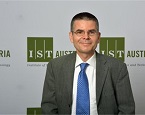Peter Jonas
Professor Peter Jonas, Institute of Science and Technology, Austria
Structure, function, and plasticity of a central glutamatergic synapse
11:20 - 12:20, Thursday 15th April
Biography

Peter Jonas studied Medicine at the University of Giessen, Germany. He obtained his MD in 1986 in Physiology in the group of Werner Vogel. After a short time as a postdoc, he moved to the Max Planck Institute for Medical Research, Heidelberg, Germany, as a senior postdoc, working with the Nobel laureate Bert Sakmann from 1990–1994. In 1994, he took over a position as associate professor at the Technical University of Munich, Germany. In 1995, he accepted a position as full professor and head of department at the University of Freiburg, becoming the youngest full professor of physiology in Germany. In November 2010, he moved to IST Austria as a full professor and founder of the Neuroscience Research Cluster at the Institute. Peter Jonas received several research prizes, including the Gottfried Wilhelm Leibniz award, the Fick award, the Tsungming Tu award, two ERC advanced grants, and the Wittgenstein Award of the Austrian Minister of Science, Research and Economy and the Austrian Science Fund. He is elected member of the German National Academy of Sciences Leopoldina, the Academy of Sciences Heidelberg, the Academia Europaea, and the European Molecular Biology Organization. Furthermore, he is member of the Board of Reviewing Editors of the journals Science and Neuron. The research interests of Peter Jonas focus on synaptic transmission and plasticity, microcircuit function, GABAergic interneurons, mechanisms of exocytosis, subcellular patch-clamp recording, structural analysis of synapses, and quantitative modeling.
Abstract
Synaptic transmission was previously characterized in a limited number of model synapses, notably the giant synapse of the squid and the calyx of Held in the auditory brainstem of mammals. In these synapses, the large size of presynaptic terminals permitted direct access to the presynaptic site, allowing analysis of synaptic transmission at the biophysical level. However, whether the conclusions from these synapses can be extrapolated to cortical synapses remains unclear. The hippocampal mossy fiber synapse, formed between the axons of granule cells and the dendrites of CA3 pyramidal neurons, is a key synapse in the trisynaptic circuit of the hippocampus. A hallmark property of this synapse is the comparatively large size of the presynaptic terminals, making them more accessible to direct recording than any other cortical synapse. To characterize the biophysical properties of transmission and plasticity at this synapse, we combined paired recordings from mossy fiber terminals and postsynaptic CA3 neurons and “flash and freeze” functional electron microscopy experiments. We found that post-tetanic potentiation (PTP), a major form of presynaptic plasticity, was generated by an increase in the size of the readily releasable pool of synaptic vesicles. PTP was associated with an increase in the docked vesicle pool, suggesting the formation of structural “pool engrams”. Thus, PTP is associated with both functional and structural changes in the organization of vesicle pools. In conclusion, our results reveal the functional and structural mechanisms underlying presynaptic plasticity at a cortical synapse, and provide clues how synaptic properties shape higher-order computations and short-term memory in neuronal networks.
References
- Zhang X, Schlögl A, Jonas P (2020) Selective routing of spatial information flow from input to output in hippocampal granule cells. Neuron 107, 1212–1225.
- Vandael D, Borges-Merjane C, Zhang X, Jonas P (2020) Short-term plasticity at hippocampal mossy fiber synapses is induced by natural activity patterns and associated with vesicle pool engram formation. Neuron 107, 509–521.
- Borges-Merjane C, Kim OS, Jonas P (2020) Functional electron microscopy, “flash and freeze”, in identified cortical synapses in acute brain slices. Neuron 105, 992–1006.
Additional websites
See the Jonas lab website here
